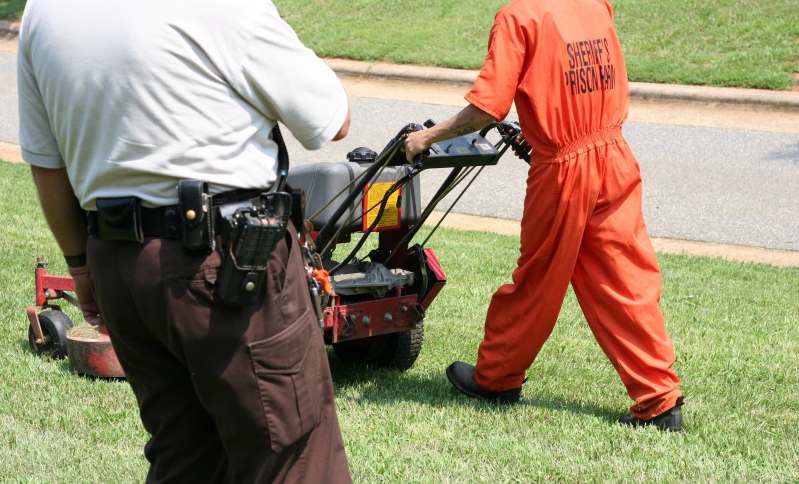
Experts are debating whether current workplace protections adequately shield incarcerated workers.
The Occupational Safety and Health Administration (OSHA), a division of the U.S. Department of Labor, requires that employers provide a safe and healthy workplace for their workers—unless those workers are incarcerated.
Approximately 2.3 million people are incarcerated and 55 percent of those incarcerated individuals work while serving their sentences. The Bureau of Prisons requires that most incarcerated people in federal prisons work. Incarcerated workers often contribute to prisons’ day-to-day operations, such as by working in food service, laundry facilities, or groundskeeping. Incarcerated workers also provide critical services and products for the outside world, often in times of crisis. For instance, they fought wildfires in California in recent years and produced hand sanitizer and face masks during the coronavirus pandemic.
The Bureau of Prisons provides health and safety requirements for incarcerated workers in federal prisons through its occupational health and safety program. This policy includes annual safety training for incarcerated workers, investigations into work-related injuries, and compensation for lost wages due to workplace injuries. Injury compensation, however, is restricted to individuals working through the Federal Prison Industries and work assignments related to the maintenance of the facility.
States individually determine protections for state prison workers, and some states do not grant many protections at all. Pennsylvania, for instance, allows incarcerated workers who suffer work-related injuries to receive compensation for lost wages. Texas, on the other hand, explicitly excludes, via statute, incarcerated workers from receiving work-related injury compensation.
The Incarcerated Workers Organizing Committee, an organization led by incarcerated workers, draws awareness to the inconsistent and sometimes complete lack of safety regulations, worker compensation, and low wages for their workplaces. This committee argues that earning money while in prison can be critical to support reentry into society, pay victim restitution, and support their families. The committee further emphasizes that prison workers are some of the most exploited workers in the country, earning sometimes mere pennies per hour, and are at least owed safe work environments.
Criminal justice policy experts, such as Lauren-Brooke Eisen of the Brennan Center for Justice, agree that existing policies on workplace safety and rights for incarcerated workers do not provide adequate protection. Eisen and other experts argue that the Labor Department should extend health and safety protections to prison workers.
Experts also emphasize the lack of data related to workplace conditions and injuries in corrections facilities due to the shortage of federal regulations. The lack of data makes it difficult for researchers and policymakers to understand the full extent of the impact of existing and non-existing incarcerated workplace safety standards.
Although officially reported data is in short supply, allegations about unsafe workplace conditions and on-the-job injuries are abundant. In Georgia, for instance, one person lost his leg after falling in the prison kitchen and another worker lost his life after a car hit him at a highway worksite. Furthermore, an investigative journalist in California reported hundreds of workplace injuries of incarcerated workers due, in part, to improper workplace safety regulations.
The enactment of the 13th Amendment of the U.S. Constitution abolished involuntary servitude, except for as punishment for individuals convicted of a crime. Scholars argue that the 13th Amendment replaced slave labor with free prison labor, leading to the exploitation of incarcerated people and mass incarceration in the United States. Yet incarcerated workers are not explicitly excluded in the definition of employees protected under the Fair Labor Standards Act—the statute that guarantees a federal minimum wage and provides overtime protections.
Courts, however, have often interpreted the Fair Labor Standards Act to exclude incarcerated workers. Scholars argue that this exclusion deprives incarcerated workers of adequate protection and perpetuates mass incarceration. They recommend that the Labor Department expand its definition of employee to include explicitly incarcerated workers.
Some scholars suggest that covering prison workers under the Fair Labor Standards Act and other regulation would guarantee minimum standards of protection for prison workers. Such coverage may also lead to lower rates of reoffending because it could increase economic resources people desperately need when released from prison and better ensure that they are not injured and unable to work upon release.
Although not much attention has been paid to the regulation of workplace conditions for incarcerated workers, advocates, scholars, and incarcerated workers themselves urge that more must be done. Eisen described the government’s current failure to expand workplace protections and fair labor standards to incarcerated workers as “not far off from the devaluation and brutalization of slave labor that was ostensibly abandoned a century and a half ago.”



